MotoGP Qualifying: What Determines The Starting Grid

Table of Contents
MotoGP Qualifying: What Determines the Starting Grid?
MotoGP, the pinnacle of motorcycle racing, is a spectacle of speed, skill, and strategy. But before the lights go out and the roar of engines fills the air, the all-important qualifying session determines the starting grid. Understanding how this crucial part of the weekend unfolds is key to appreciating the drama and intricacies of the race itself. This article delves into the complexities of MotoGP qualifying, explaining what factors determine a rider's starting position.
The Qualifying Format: A Breakdown
The current MotoGP qualifying format is designed to create excitement and showcase the riders' skills under pressure. It involves several stages, each with its own significance:
Q1: The Fight for Q2
The qualifying sessions begin with Q1, where the riders who didn't finish within the top 10 in the combined Free Practice times (FP1, FP2, and FP3) compete. This session is a high-stakes battle, as only the top two riders from Q1 progress to the decisive Q2. The remaining riders in Q1 will start the race from positions 13 to 20, based on their times in this session.
Q2: The Showdown for Pole Position
Q2 brings together the top 10 riders from the combined Free Practice sessions and the two fastest from Q1. This is where the fight for pole position truly intensifies. These elite riders have 15 minutes to set their fastest lap time, with the rider achieving the quickest time securing pole position – the coveted starting spot on the grid. The grid positions for the top 12 riders in the race are determined by their times in Q2.
Factors Influencing Qualifying Performance
Many factors contribute to a rider's success in qualifying. It's not just about raw speed; it's a complex interplay of several elements:
1. Rider Skill and Experience:
The most obvious factor is the rider's skill and experience. Years of honing their abilities, understanding their machine, and managing tire wear under pressure directly translate to faster lap times. A rider's ability to push the limits without making mistakes is crucial in the intense qualifying sessions.
2. Motorcycle Performance and Setup:
The motorcycle's performance and setup are paramount. Teams spend countless hours meticulously fine-tuning their bikes for each track, aiming for optimal handling, acceleration, and braking. Even the smallest adjustments can make a significant difference in lap times. This includes factors like engine mapping, suspension settings, and aerodynamic efficiency.
3. Track Conditions and Weather:
Track conditions and weather play a vital role. The temperature of the track surface, humidity, and even wind can all influence lap times. Riders and teams need to be highly adaptable, constantly analyzing and reacting to changing conditions to make the necessary adjustments.
4. Tire Choice and Management:
The choice and management of tires is critical. Choosing the right compound for the session and managing tire wear over a series of flying laps requires considerable skill. The goal is to have optimal grip throughout the entire qualifying run without overheating or degrading the tires prematurely.
5. Team Strategy and Support:
The team's strategy and support are often overlooked but incredibly important. The team provides crucial data analysis, setup adjustments, and valuable feedback to the rider, ensuring the best possible performance. Efficient pit stops and seamless communication are critical for a successful qualifying session.
The Importance of Qualifying Position
Securing a good starting position is hugely advantageous in MotoGP. A front-row start provides a significant tactical advantage, often enabling riders to control the race from the very beginning. A better starting position significantly reduces the chance of getting involved in early-race incidents and enhances the opportunity to capitalize on the initial race momentum.
Conclusion: More Than Just Speed
MotoGP qualifying is a multifaceted process involving a blend of rider skill, team strategy, machine performance, and track conditions. It’s more than just raw speed; it’s about maximizing every element to secure the best possible starting position and set the stage for a thrilling race. Understanding the qualifying format and its nuances is crucial for fully appreciating the strategic depth and exciting competition of the world's premier motorcycle racing championship.

Thank you for visiting our website wich cover about MotoGP Qualifying: What Determines The Starting Grid. We hope the information provided has been useful to you. Feel free to contact us if you have any questions or need further assistance. See you next time and dont miss to bookmark.
Featured Posts
-
Moto2 Bike Specs Unlocking The Secrets Of Speed
Feb 17, 2025
-
Inside The World Of Moto2 Racing
Feb 17, 2025
-
Unlock Exclusive Access F1 Parking Pass
Feb 17, 2025
-
Moto Gp Sprint Races A Celebration Of Speed And Skill
Feb 17, 2025
-
Feel The Adrenaline Race Bikes Ready To Ride
Feb 17, 2025
